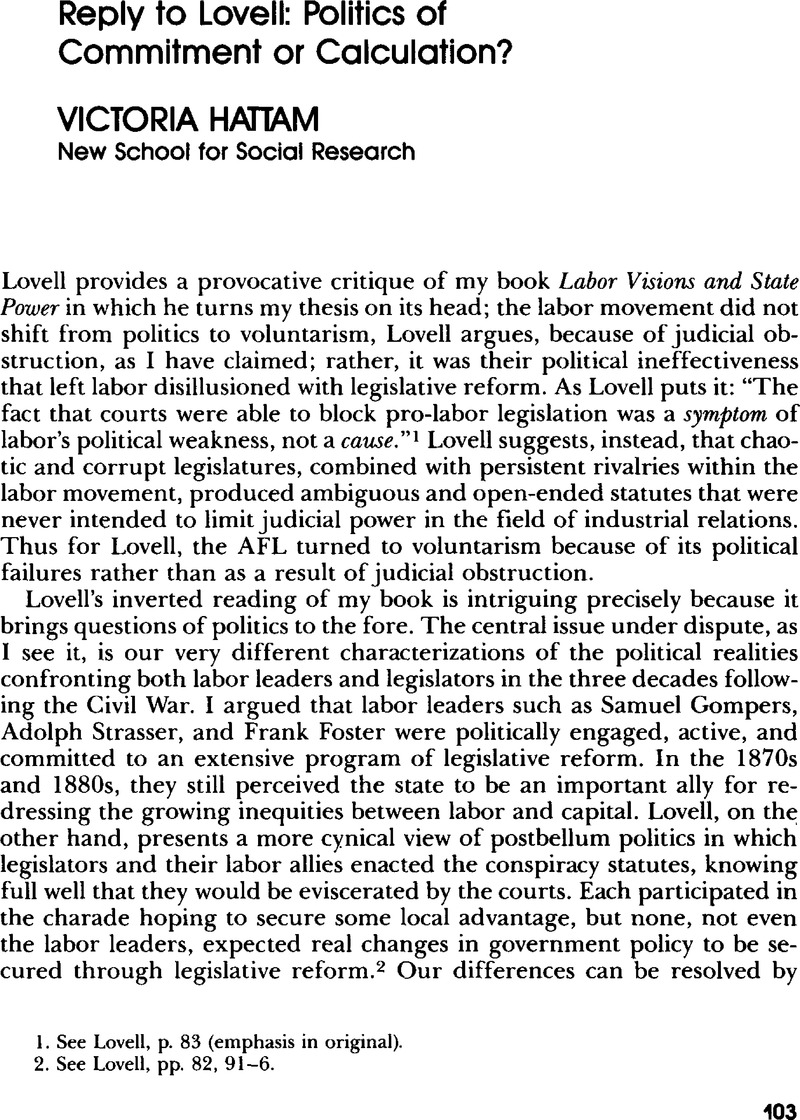Published online by Cambridge University Press: 16 December 2008

1. See Lovell, p. 83 (emphasis in original).
2. See Lovell, pp. 82, 91–6.
3. Interestingly, Lovell actually claims that he selected my project as the focus of his critique because it has a more limited time frame than that of William Forbath. As Forbath's study covers the period from 1880 through 1930 and mine from 1806 through 1896, this is a difficult proposition to sustain. I suspect that Lovell thinks of my project as narrower precisely because he ignores the entire antebellum argument presented in chapters 2 and 3.
4. Lovell incorrectly claims that I considered Barrett's discussion of intimidation in the Wilzig and Kostka trials to be inappropriate. In fact, what I argued was that intimidation became the test of what was to constitute lawful and criminal collective action and that Barrett gave a very broad definition of the term in these two cases, there by largely undermining any statutory protection. See Hattam, , Labor Visions and State Power, 146–9.Google Scholar
5. I elaborate this argument concerning the impact of the anticonspiracy statutes in my discussion of the transition from conspiracy to labor injunction. See Hattam, , Labor Visions and State Power, pp. 161–2.iGoogle Scholar
6. Quoted from Lovell, pp. 91, 94.
7. It is important to remember that many labor leaders themselves described their activities in the 1880s and early 1890s as entailing a strong commitment to legislative politics, which they later abandoned due to repeated judicial obstruction. For example see McBride, Gompers, and Strassers' comments in Labor Visions and State Power, pp. 153–61. For discussion of the Workingmen's Assembly's legislative campaign, see pp. 150–5, 153–6. For comparison of different labor organizations' response to the postbellum conspiracy trials, see pp. 166–71.
8. For example, the 1888 constitution of the CLU still demanded repeal of the conspiracy laws alongside their other legislative measures. See Constitution and By-Laws of the Central Labor Union of New York City and Vicinity (New York: W. Rodgers & Co., 1888), p. 5.Google Scholar
9. For example, Lovell needs to explain why the longstanding problem of rotten boroughs in English politics and divisions within the English labor movement between organizations such as the London Working Men's Association, the Working Men's Parliamentary Association, and the London Association were less significant than the corruption and division within their New York counterparts. As it stands, Lovell makes no attempt to test his alternative explanation with any comparative data.
10. Lovell argues that the introduction of elective judiciaries at midcentury tied the level of judicial power to the prevailing balance of political forces. All scholarship on the impact of the elective judiciary, however, suggests otherwise. The introduction of elective judiciaries seems to have had little impact unjudicial policy. The political sources of judicial power lie elsewhere than in these structural mechanism.